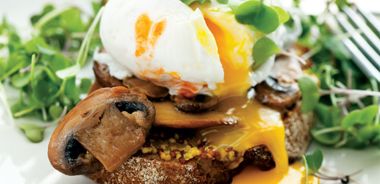Poached Eggs, Mushrooms, and Micro Greens

This dish works for either dinner or brunch on a lazy Sunday afternoon. Look for rye bread with rye flour or rye meal as the first ingredients instead of wheat flour, a euphemism for white refined flour.
1 Tbsp (15 mL) unsalted butter
1 Tbsp (15 mL) oil, such as grapeseed
1/2 lb (225 g) button mushrooms, sliced (about 3 cups)
4 large free-range eggs
1 Tbsp (15 mL) white vinegar
2 Tbsp (30 mL) grainy mustard
4 slices rye bread, lightly toasted
Salt and pepper, to taste
Hot sauce, optional
1 cup (250 mL) micro greens
Heat butter and oil over medium heat in skillet. As soon as butter foam subsides add mushrooms and cook 6 minutes, or until softened and light brown. Remove pan from heat and set aside.
To poach eggs, fill lidded large skillet with water and bring to a boil. Break eggs into separate teacups or small bowls. Add vinegar to boiling water. Gently tip eggs into pan, and immediately turn off heat and cover tightly. Let sit for 4 minutes. Using slotted spoon or spatula, carefully remove poached eggs from water and set on clean dish towel to drain.
Spread an even amount of mustard on toasted rye slices. Top with mushrooms and poached eggs. Season eggs with salt and pepper, and a few squirts of hot sauce if desired. Garnish with micro greens.
Serves 4.
Each serving contains: 228 calories; 11 g protein; 13 g total fat (4 g sat. fat, 0 g trans fat); 18 g carbohydrates; 3 g fibre; 370 mg sodium
source: "MIcrogreens", alive #355, April 2012





